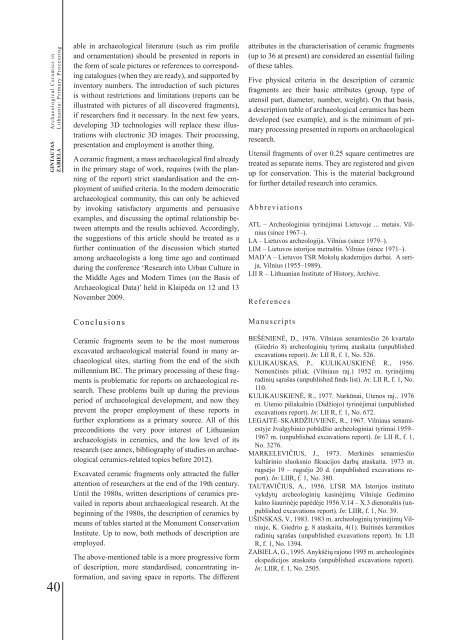BALTICA16 - Klaipėdos universitetas
BALTICA16 - Klaipėdos universitetas
BALTICA16 - Klaipėdos universitetas
You also want an ePaper? Increase the reach of your titles
YUMPU automatically turns print PDFs into web optimized ePapers that Google loves.
Archaeological Ceramics in<br />
Lithuania: Primary Processing<br />
GINTAUTAS<br />
ZABIELA<br />
40<br />
able in archaeological literature (such as rim profile<br />
and ornamentation) should be presented in reports in<br />
the form of scale pictures or references to corresponding<br />
catalogues (when they are ready), and supported by<br />
inventory numbers. The introduction of such pictures<br />
is without restrictions and limitations (reports can be<br />
illustrated with pictures of all discovered fragments),<br />
if researchers find it necessary. In the next few years,<br />
developing 3D technologies will replace these illustrations<br />
with electronic 3D images. Their processing,<br />
presentation and employment is another thing.<br />
A ceramic fragment, a mass archaeological find already<br />
in the primary stage of work, requires (with the planning<br />
of the report) strict standardisation and the employment<br />
of unified criteria. In the modern democratic<br />
archaeological community, this can only be achieved<br />
by invoking satisfactory arguments and persuasive<br />
examples, and discussing the optimal relationship between<br />
attempts and the results achieved. Accordingly,<br />
the suggestions of this article should be treated as a<br />
further continuation of the discussion which started<br />
among archaeologists a long time ago and continued<br />
during the conference ‘Research into Urban Culture in<br />
the Middle Ages and Modern Times (on the Basis of<br />
Archaeological Data)’ held in Klaipėda on 12 and 13<br />
November 2009.<br />
Conclusions<br />
Ceramic fragments seem to be the most numerous<br />
excavated archaeological material found in many archaeological<br />
sites, starting from the end of the sixth<br />
millennium BC. The primary processing of these fragments<br />
is problematic for reports on archaeological research.<br />
These problems built up during the previous<br />
period of archaeological development, and now they<br />
prevent the proper employment of these reports in<br />
further explorations as a primary source. All of this<br />
preconditions the very poor interest of Lithuanian<br />
archaeologists in ceramics, and the low level of its<br />
research (see annex, bibliography of studies on archaeological<br />
ceramics-related topics before 2012).<br />
Excavated ceramic fragments only attracted the fuller<br />
attention of researchers at the end of the 19th century.<br />
Until the 1980s, written descriptions of ceramics prevailed<br />
in reports about archaeological research. At the<br />
beginning of the 1980s, the description of ceramics by<br />
means of tables started at the Monument Conservation<br />
Institute. Up to now, both methods of description are<br />
employed.<br />
The above-mentioned table is a more progressive form<br />
of description, more standardised, concentrating information,<br />
and saving space in reports. The different<br />
attributes in the characterisation of ceramic fragments<br />
(up to 36 at present) are considered an essential failing<br />
of these tables.<br />
Five physical criteria in the description of ceramic<br />
fragments are their basic attributes (group, type of<br />
utensil part, diameter, number, weight). On that basis,<br />
a description table of archaeological ceramics has been<br />
developed (see example), and is the minimum of primary<br />
processing presented in reports on archaeological<br />
research.<br />
Utensil fragments of over 0.25 square centimetres are<br />
treated as separate items. They are registered and given<br />
up for conservation. This is the material background<br />
for further detailed research into ceramics.<br />
Abbreviations<br />
ATL – Archeologiniai tyrinėjimai Lietuvoje ... metais. Vilnius<br />
(since 1967–).<br />
LA – Lietuvos archeologija. Vilnius (since 1979–).<br />
LIM – Lietuvos istorijos metraštis. Vilnius (since 1971–).<br />
MAD’A – Lietuvos TSR Mokslų akademijos darbai. A serija,<br />
Vilnius (1955–1989).<br />
LII R – Lithuanian Institute of History, Archive.<br />
References<br />
Manuscripts<br />
BEŠĖNIENĖ, D., 1976. Vilniaus senamiesčio 26 kvartalo<br />
(Giedrio 8) archeologinių tyrimų ataskaita (unpublished<br />
excavations report). In: LII R, f. 1, No. 526.<br />
KULIKAUSKAS, P., KULIKAUSKIENĖ R., 1956.<br />
Nemenčinės piliak. (Vilniaus raj.) 1952 m. tyrinėjimų<br />
radinių sąrašas (unpublished finds list). In: LII R, f. 1, No.<br />
110.<br />
KULIKAUSKIENĖ, R., 1977. Narkūnai, Utenos raj., 1976<br />
m. Utenio piliakalnio (Didžiojo) tyrinėjimai (unpublished<br />
excavations report). In: LII R, f. 1, No. 672.<br />
LEGAITĖ–SKARDŽIUVIENĖ, R., 1967. Vilniaus senamiestyje<br />
žvalgybinio pobūdžio archeologiniai tyrimai 1959–<br />
1967 m. (unpublished excavations report). In: LII R, f. 1,<br />
No. 3276.<br />
MARKELEVIČIUS, J., 1973. Merkinės senamiesčio<br />
kultūrinio sluoksnio fiksacijos darbų ataskaita. 1973 m.<br />
rugsėjo 19 – rugsėjo 20 d. (unpublished excavations report).<br />
In: LIIR, f. 1, No. 380.<br />
TAUTAVIČIUS, A., 1956. LTSR MA Istorijos instituto<br />
vykdytų archeologinių kasinėjimų Vilniuje Gedimino<br />
kalno šiaurinėje papėdėje 1956.V.14 – X.3 dienoraštis (unpublished<br />
excavations report). In: LIIR, f. 1, No. 39.<br />
UŠINSKAS, V., 1983. 1983 m. archeologinių tyrinėjimų Vilniuje,<br />
K. Giedrio g. 8 ataskaita, 4(1). Buitinės keramikos<br />
radinių sąrašas (unpublished excavations report). In: LII<br />
R, f. 1, No. 1394.<br />
ZABIELA, G., 1995. Anykščių rajono 1995 m. archeologinės<br />
ekspedicijos ataskaita (unpublished excavations report).<br />
In: LIIR, f. 1, No. 2505.

















